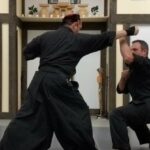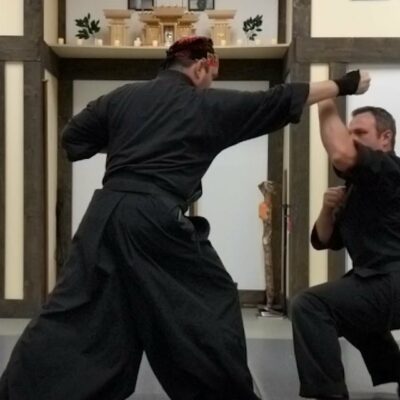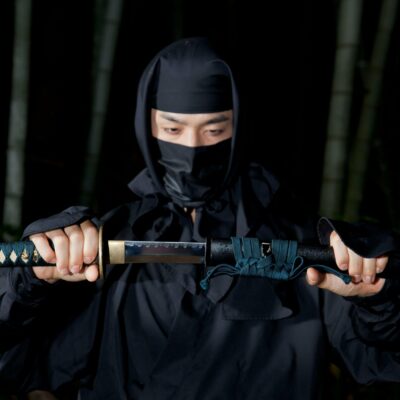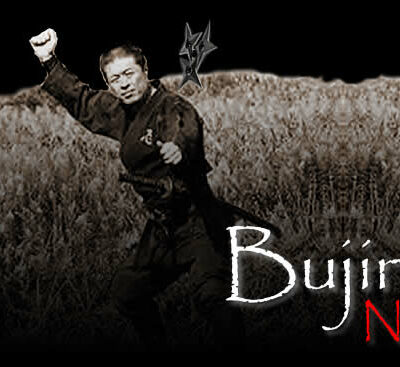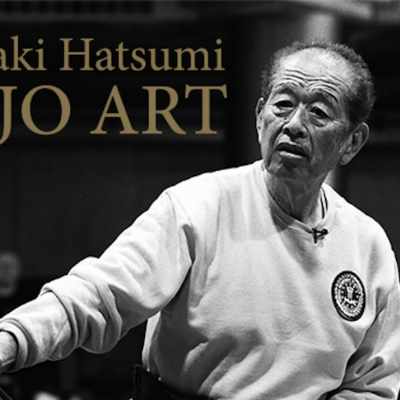I have to confess: I haven’t been the best teacher. I rarely do the Sanshin in class. I figured it was super simple, and takes away the precious time we have in class from the “real training” where techniques are applied. Frankly, I thought it was a little boring and a bit redundant. Then I started noticing Hatsumi Sensei putting a lot of emphasis on the Sanshin, and saying how important it was for training. So I decided to take a second look.
The Sanshin no Kata (三心の型) is a set of 5 movements trained using three different methods. The five movements are:
- Chi no Kata (地の型) “Earth Example”
- Sui/Mizu no Kata (水の型) “Water Example”
- Ka/Hi no Kata (火の型) “Fire Example”
- Fu/Kaze no Kata (風の型) “Wind Example”
- Ku no Kata (空の型) “Void Example”
Note: The above elements correspond to an old method of counting. Although Stephen K. Hayes used elements as a way to classify and describe movements, this is his own invention and does not correspond to anything within Bujinkan nor Japanese training. The elements themselves are only used as a method of counting – nothing more.
Update: After consulting with a number of practitioners that were around in the early days, apparently Hatsumi Sensei would use it as an analogy. Stephen K Hayes ran with that idea to create his method of classifying movement via the Godai. However, the opinion seems to be that it was a bit too simplistic to classify everything purely as a type of element. When Hayes parted ways with the Bujinkan, the Japanese distanced themselves from this idea.
The name Sanshin is often translated as “three hearts”. However, the kanji shin (心) can also be translated as “mind”. In western language we tend to separate the idea of the mind as that of logic, and heart involving emotion or character. It may be more correct then to read the Sanshin as “Three Minds” or “Three Mindsets”. The number three refers to the 3 different ways to train the movements. The three methods are:
- Shoshin Gokei (初心五型) “Beginners Mind Five Types”
- Gogyo no Kata (五行の型 ) “Five Element Examples”
- Goshin no Kata (悟心の型) “Enlightened Mind Example”
While the core movements of the Sanshin do not change, how they are trained depends on which of the above methods is utilized.
The Shoshin Gokei level or method involves performing the 5 kata solo against an imaginary opponent.
From a practical sense, this could be viewed as the most rudimentary level of the training where a beginner begins to develop the primary or base movement of Gyokko Ryu.
Each kata is done consciously to condition the hand and leg coordination of the body. Simply put, the student is learning how to perform each movement.
However, we can dig a little deeper by looking at the choice of naming this level as “Shoshin”; in Zen Buddhism this phrase means to have an open mind when studying a subject. To have Shoshin is to leave any preconceptions behind and to view the subject fresh every time.
In terms of the movements, this would carry a spirit of exploring. This allows focus to change within practice of the movement.
In my own training I have been emphasizing how the hips move to create power . It feels to me as this is built within each of the Sanshin movements. Yet, that only reflects my own training.
When Shiraishi Sensei demonstrated the Sanshin, he performed with a sensation of almost falling forward in addition to his “foot, spine, hand” methodology. When Noguchi Sensei demonstrated it, there was an emphasis on swinging the arms to generate momentum. Someya Sensei emphasized proper shifting of weight and angling of attack. While the core movements were the same for each, emphasis changed, as each shared what they felt at the time was the hidden value of the movement.
When the 5 movements are practiced as Gogyo no Kata, they are performed against an opponent. At this level, a student learns how the theory of the base movement translates into training against an opponent.
The Gogyo forces the student to take timing, distance, and other factors into account when applying the technique against an attacker. The movements should only be adjusted minimally to apply them, but never the less require adjustment; different height/reach of attackers may require adjustment in distance and foot work, the attack itself may require a different vector of attack, the strike may need to be adjusted depending on the opening and distance, etc. etc. The point is to fine tune the base movements, as well as learn how to adapt when conditions vary.
The last level is Goshin; the wisdom mind. Here, the kata are performed as a method of meditation to obtain enlightenment. While the first two levels require conscientious focus to develop and adapt correct movement, this stage almost requires the absence of conscience thought; the movements are done continuously – moving in and out of each kata spontaneously – until the practitioner obtains a moment of “enlightenment”.
Enlightenment in this sense would be some kind of epiphany. Almost universally, meditation involves some aspect of quieting the mind, and the Sanshin in this case is used as a vehicle for that. I believe this has two functions; first you’re training your body to move unconsciously, and secondly you’re allowing yourself to observe your movement in an abstract and detached way.
It’s interesting that in many ways the Sanshin corresponds to the concept of Shuhari, which is a Japanese view of the path of mastery. We did a more in-depth article explaining Shuhari that you can read here. However, Shuhari can be translated as “preserve/copy, break, transcend”. In terms of the Sanshin, Shoshin can be equated to first learning by copying (Shu – Preserve/Copy), then Gogyo learning how to adapt for application (Ha – Break), and finally Goshin learning something deeper than the movement itself (Ri – Transcend).
This means that the Sanshin is an analogy or allegory for learning in general; it functions as a blueprint on how students are to learn. Not only does it teach core mechanical movements that are built upon later, it also supplies the intended methodology for learning in general.
This means that the Sanshin is not only much deeper than a set of basic body movements, but is one of the most important items in the entire art.
Hatsumi Sensei has said that the Sanshin is having the “mind of a three year old”. At three years old the brain is in a state of rapid learning absorbing huge amounts of information at a time. Alison Gopnik, a Child Developmental Psychologist, gives a great analogy in her Ted Talk:
Adults’ attention and consciousness look kind of like a spotlight.So what happens for adults is we decide that something’s relevant or important,we should pay attention to it.Our consciousness of that thing that we’re attending to becomes extremely bright and vivid,and everything else sort of goes dark…So we have a very focused, purpose-driven kind of attention. If we look at babies and young children, we see something very different. I think babies and young children seem to have more of a lantern of consciousness than a spotlight of consciousness. So babies and young children are very bad at narrowing down to just one thing. But they’re very good at taking in lots of information from lots of different sources at once.
Alison Gopnik
I believe this idea is what Soke is referring to when he says to “think like a three year old”; he is saying to have what Alison called a “lantern of consciousnesses”. So next time your tempted to skip the “easy” or “boring” stuff to get to the “real” thing (like I did), stop and take a second look; you might be surprised at what you’re missing.


